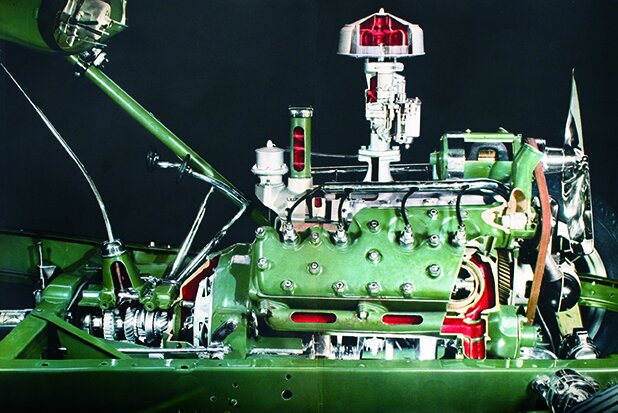Ford Flathead: The First Performance V-8
April 2020 • By Tony Thacker with Mike Herman, HandHFlatheads.comHenry Ford was unaware that his new flathead V-8 was eventually going to set the racing fraternity on its head. Introduced in 1932, it lasted more or less unchanged until 1953, longer in other countries outside the USA.
The Ford flathead V8 was designed from the outset to be a performer but I doubt Henry Ford ever envisaged the performance his hastily engineered monobloc would go on to produce almost 100 years after its birth.
After a run of 19 years, Ford had sold more than 15 million of his beloved Model Ts. He didn’t want to move on but the T was an outdated anchor and the competition was introducing bigger, better, faster cars. Chevrolet was outselling Ford and going to a six, Ford said, “We’re going from a four to an eight because Chevrolet is going to a six.” Of course, Henry had also said, “I’ve got no use for a motor that has more spark plugs that a cow has teats.”
The Ford motor test lab in 1934 when aluminum cylinder heads were added.
Indy’s ‘Junk Formula’ allowed barely modified flatheads to race the Brickyard, none to successfully.
Engine development at Ford had been ongoing if a little haphazardly. There had been an X-8 begun in 1922 but it was abandoned in 1928 when work began on the V-8. Engineer Fred Thoms assembled a bunch of wrecking-yard engines that came mainly from up-market cars such as Cadillac, LaSalle, and even Lincoln. Most were of multiple construction consisting of cylinder blocks and crankcases bolted together. Planning to build 3,000 engines a day, Henry wanted a cheap, simple V-8 to power a car that would sell for under $600. Everybody’s comment was that a low-priced, mass-produced V-8 cast in one-piece was impossible. Henry’s answer was, “Anything that can be drawn up can be cast.”
Development began in earnest early in 1930 but Henry was a cantankerous SOB. He didn’t want an oil pump, he wanted the distributor driven directly off the front of the camshaft and he didn’t really want any water pumps preferring the thermosyphon system.
Many of the flathead’s inherent problems were resolved towards the end of it’s life with the 1948 introduction of what is commonly known as the 8BA.
Robert E. Petersen, with camera at El Mirage, launched HOT ROD Magazine in January 1948.
The 90-degree V-8 that finally went into production on March 10, 1932, was all that Henry wanted but it was not without its problems. Designated Model 24 with 232 ci, it overheated like a tea kettle and produced a mere 85 hp. It was not about to win many races. There was a class for Ford V-8 powered cars at Indy but it was nicknamed the ‘Junk Formula’ and was gone by 1935.
This supercharged flathead Ford-powered ’27 Roadster, now owned by Scott Perrott, was a test bed for Barney Navarro’s early speed equipment.
It wasn’t really until after World War II when the V-8 had been further developed that hot rodders adopted it. Until then a hopped-up Model A four-banger could be just as fast. However, the returning service personnel found the V-8 cheap, plentiful and now easily tunable with all the speed equipment that began to flood the market. Heads, intakes and cams were quickly designed and manufactured in Southern California where there was an abundance of aircraft subcontractors looking for a little on the side. Names such as Edelbrock, Moon, Navarro, and Sharp became household in families that liked racecars. And, just a few hours drive north of Los Angeles there were dry lakes to race flat out across at speeds of 100 mph or more.
As the decade neared its end two impactful things happened: Robert E. Peterson launched HOT ROD Magazine in January 1948 gave a worldwide voice to the hobby/industry. Also that year Ford introduced the last generation flathead V-8 commonly known as the 8BA. The top line Mercury version featured a 4-inch stroke crank that equated to a capacity of 255 ci. Stock, it produced 125 hp (93kW) and 218 lb-ft or torque for 1953, the final year of production.
Ford 8BA rebulit by HandHFlatheads.com
It had been a long time coming but hot rodders finally loved the Ford flathead V-8. They were cheap, plentiful and despite their shortcomings, infinitely tunable. Sure they got pushed aside when the overhead valve Chrysler Hemi and small-block Chevys came along but even today, almost 90 years after their introduction companies such as HandHFlatheads.com continue to build two engines a week shipping them all over the world along with speed equipment still made in Southern California.
Barney Navarro’s legacy, a 59A with a S.Co.T.-supercharger, twin Stromberg 97s and brand new Navarro heads that are Made in USA.








